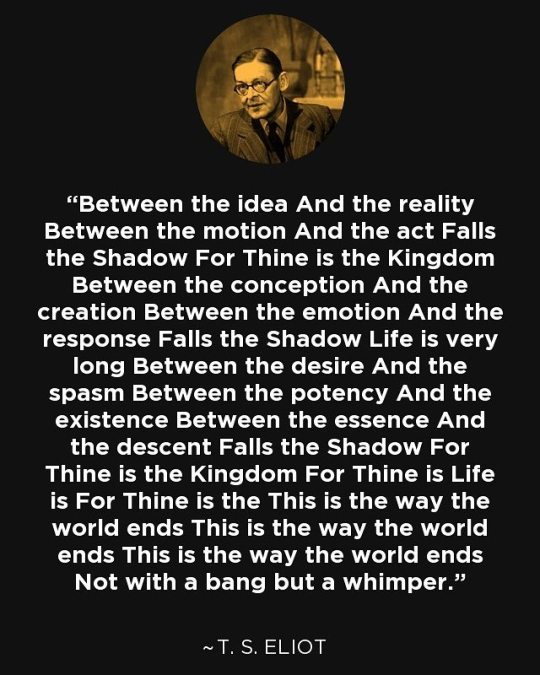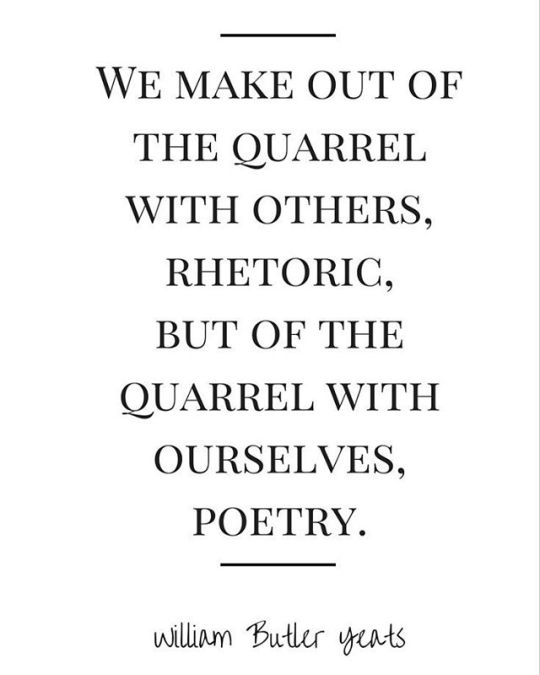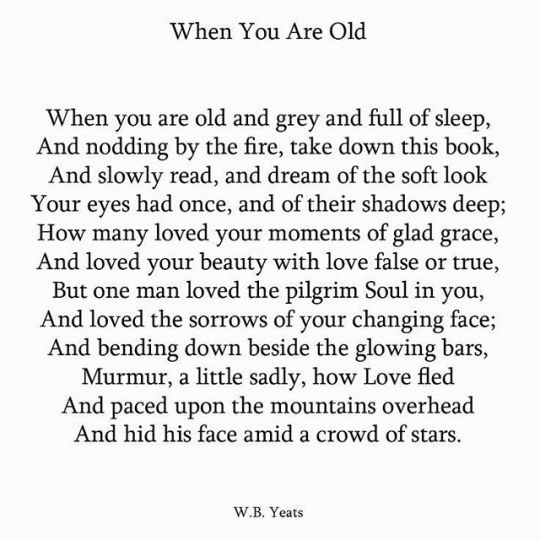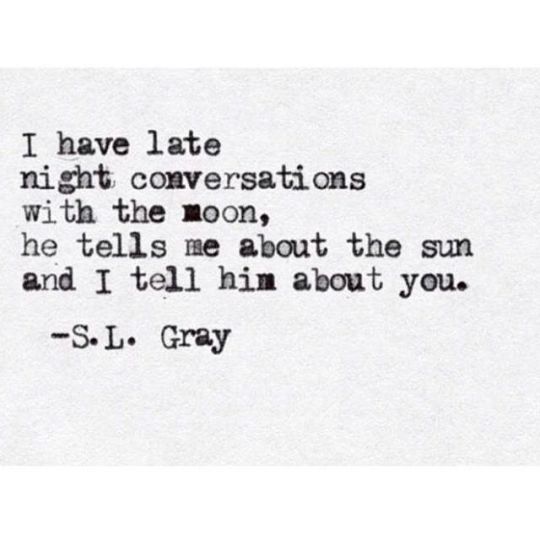Quote
Master Lincoln, he's a great man, and I am a poor negro; but the negro can tell master Lincoln how to save the money and the young men. He can do it by setting the negro free. Suppose that was an awful big snake down there, on the floor. He bite you. Folks all scared, because you die. You send for a doctor to cut the bite; but the snake, he rolled up there, and while the doctor doing it, he bite you again. The doctor dug out that bite; but while the doctor doing it, the snake, he spring up and bite you again; so he keep doing it, till you kill him. That's what master Lincoln ought to know.
Harriet Tubman on President Lincoln’s reluctance to take a firm abolitionist stance against slavery. By addressing the wounds of slavery rather than slavery itself, the problems will never go away. Slavery, like the snake, must be killed.
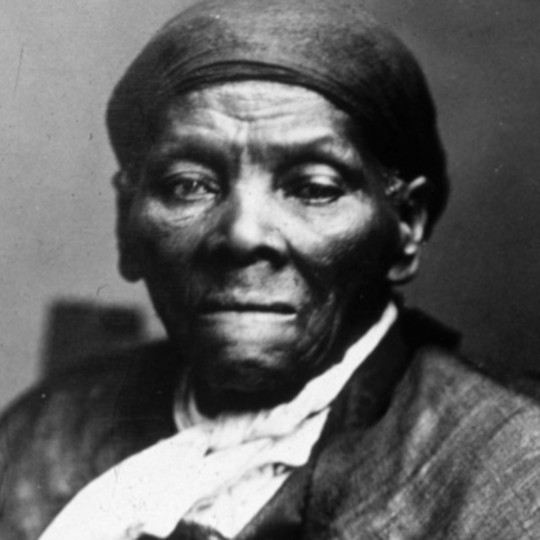
On December 12, we will be releasing our newest book, Harriet Tubman For Beginners by Annette Alston and illustrated by Lynsey Hutchinson. Follow this blog to learn more about Harriet’s life and legacy as we lead up to the release.
8 notes
·
View notes
Text
In exciting news, the renowned artist Joyce Scott has unveiled her larger-than-life, beautiful, and haunting Harriet Tubman sculptures at New Jersey’s Grounds for Sculpture. Read more about it here, and if you’re in New Jersey before April 1, 2018 - check it out!
Harriet Tubman, the Muse
Ms. Harriet Tubman has an astonishing legacy: a leader of enslaved people to freedom, a nurse, spy, and cook in the Civil War, a caretaker for the sick and elderly, and a suffragist. Her actions have touched generations of people looking to improve the quality of the human condition. Proof of her reach can be seen in the art created by those inspired by her extraordinary life.
Visual Art
In this portrait, painted by William H. Johnson, Ms. Tubman stands before a day and night connected by a railroad passing by her feet. She is tall, taller than everything else, and is wearing a bonnet that evokes a Christ-like halo – she is “the Moses of her people,” after all.
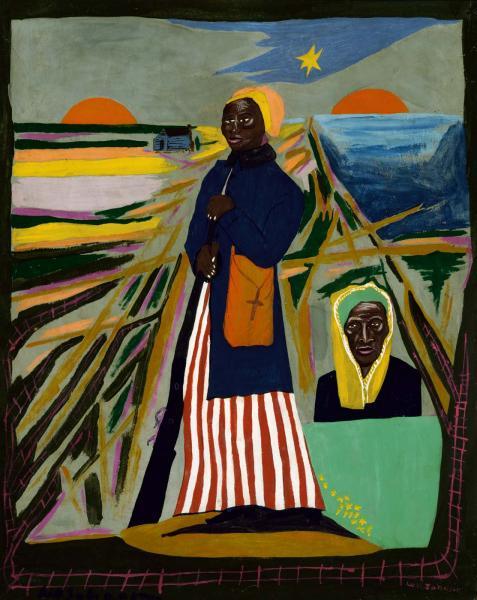
William H. Johnson, Harriet Tubman, ca. 1945, oil on paperboard, Smithsonian American Art Museum
Music
American folk music icon Woody Guthrie wrote the biographical tune “Harriet Tubman’s Ballad” in celebration of her life. The most powerful line of the song?
To Abe Lincoln this I said:
You’ve just crippled that snake of slavery
We’ve got to fight to kill him dead.
Listen here: https://www.youtube.com/watch?v=41tFOn-TJzY
Poetry
While this poem by Eloise Greenfield includes a few exaggerations about Ms. Tubman’s life, the beauty in her journey remains: her determination, selflessness, and courage ensured that she and those she led to freedom “wasn’t going to stay [a slave] either.”
Harriet Tubman
by Eloise Greenfield
Harriet Tubman didn’t take no stuff
Wasn’t scared of nothing neither
Didn’t come in this world to be no slave
And wasn’t going to stay one either
“Farewell!” she sang to her friends one night
She was mighty sad to leave ‘em
But she ran away that dark, hot night
Ran looking for her freedom
She ran to the woods and she ran through the woods
With the slave catchers right behind her
And she kept on going ‘til she got to the North
Where those mean men couldn’t find her
Nineteen times she went back to the South
To get three hundred others
She ran for her freedom nineteen times
To save Black sisters and brothers
Harriet Tubman didn’t take no stuff
Wasn’t scared of nothing neither
Didn’t come in this world to be no slave
And didn’t stay one either
And didn’t stay one either
This December, we will be releasing our newest book, Harriet Tubman For Beginners by Annette Alston and illustrated by Lynsey Hutchinson. Follow this blog to learn more about Harriet’s life and legacy as we lead up to the release.
9 notes
·
View notes
Text
Harriet Tubman, the Muse
Ms. Harriet Tubman has an astonishing legacy: a leader of enslaved people to freedom, a nurse, spy, and cook in the Civil War, a caretaker for the sick and elderly, and a suffragist. Her actions have touched generations of people looking to improve the quality of the human condition. Proof of her reach can be seen in the art created by those inspired by her extraordinary life.
Visual Art
In this portrait, painted by William H. Johnson, Ms. Tubman stands before a day and night connected by a railroad passing by her feet. She is tall, taller than everything else, and is wearing a bonnet that evokes a Christ-like halo – she is “the Moses of her people,” after all.

William H. Johnson, Harriet Tubman, ca. 1945, oil on paperboard, Smithsonian American Art Museum
Music
American folk music icon Woody Guthrie wrote the biographical tune “Harriet Tubman’s Ballad” in celebration of her life. The most powerful line of the song?
To Abe Lincoln this I said:
You’ve just crippled that snake of slavery
We’ve got to fight to kill him dead.
Listen here: https://www.youtube.com/watch?v=41tFOn-TJzY
Poetry
While this poem by Eloise Greenfield includes a few exaggerations about Ms. Tubman’s life, the beauty in her journey remains: her determination, selflessness, and courage ensured that she and those she led to freedom “wasn’t going to stay [a slave] either.”
Harriet Tubman
by Eloise Greenfield
Harriet Tubman didn’t take no stuff
Wasn’t scared of nothing neither
Didn’t come in this world to be no slave
And wasn’t going to stay one either
“Farewell!” she sang to her friends one night
She was mighty sad to leave ‘em
But she ran away that dark, hot night
Ran looking for her freedom
She ran to the woods and she ran through the woods
With the slave catchers right behind her
And she kept on going ‘til she got to the North
Where those mean men couldn’t find her
Nineteen times she went back to the South
To get three hundred others
She ran for her freedom nineteen times
To save Black sisters and brothers
Harriet Tubman didn’t take no stuff
Wasn’t scared of nothing neither
Didn’t come in this world to be no slave
And didn’t stay one either
And didn’t stay one either
This December, we will be releasing our newest book, Harriet Tubman For Beginners by Annette Alston and illustrated by Lynsey Hutchinson. Follow this blog to learn more about Harriet’s life and legacy as we lead up to the release.
#Harriet Tubman#Civil War#Underground Railroad#Art#William H. Johnson#Woody Guthrie#Eloise Greenfield#Slavery#Freedom#Legacy#ICYMI
9 notes
·
View notes
Text
Harriet Tubman, the Muse
Ms. Harriet Tubman has an astonishing legacy: a leader of enslaved people to freedom, a nurse, spy, and cook in the Civil War, a caretaker for the sick and elderly, and a suffragist. Her actions have touched generations of people looking to improve the quality of the human condition. Proof of her reach can be seen in the art created by those inspired by her extraordinary life.
Visual Art
In this portrait, painted by William H. Johnson, Ms. Tubman stands before a day and night connected by a railroad passing by her feet. She is tall, taller than everything else, and is wearing a bonnet that evokes a Christ-like halo – she is “the Moses of her people,” after all.

William H. Johnson, Harriet Tubman, ca. 1945, oil on paperboard, Smithsonian American Art Museum
Music
American folk music icon Woody Guthrie wrote the biographical tune “Harriet Tubman’s Ballad” in celebration of her life. The most powerful line of the song?
To Abe Lincoln this I said:
You’ve just crippled that snake of slavery
We’ve got to fight to kill him dead.
Listen here: https://www.youtube.com/watch?v=41tFOn-TJzY
Poetry
While this poem by Eloise Greenfield includes a few exaggerations about Ms. Tubman’s life, the beauty in her journey remains: her determination, selflessness, and courage ensured that she and those she led to freedom “wasn’t going to stay [a slave] either.”
Harriet Tubman
by Eloise Greenfield
Harriet Tubman didn’t take no stuff
Wasn’t scared of nothing neither
Didn’t come in this world to be no slave
And wasn’t going to stay one either
“Farewell!” she sang to her friends one night
She was mighty sad to leave ‘em
But she ran away that dark, hot night
Ran looking for her freedom
She ran to the woods and she ran through the woods
With the slave catchers right behind her
And she kept on going ‘til she got to the North
Where those mean men couldn’t find her
Nineteen times she went back to the South
To get three hundred others
She ran for her freedom nineteen times
To save Black sisters and brothers
Harriet Tubman didn’t take no stuff
Wasn’t scared of nothing neither
Didn’t come in this world to be no slave
And didn’t stay one either
And didn’t stay one either
This December, we will be releasing our newest book, Harriet Tubman For Beginners by Annette Alston and illustrated by Lynsey Hutchinson. Follow this blog to learn more about Harriet’s life and legacy as we lead up to the release.
#Harriet Tubman#Civil War#Underground Railroad#Art#William H. Johsnon#Woody Guthrie#Eloise Greenfield#Slavery#Freedom#Legacy#ICYMI
9 notes
·
View notes
Text
Harriet Tubman, the Muse
Ms. Harriet Tubman has an astonishing legacy: a leader of enslaved people to freedom, a nurse, spy, and cook in the Civil War, a caretaker for the sick and elderly, and a suffragist. Her actions have touched generations of people looking to improve the quality of the human condition. Proof of her reach can be seen in the art created by those inspired by her extraordinary life.
Visual Art
In this portrait, painted by William H. Johnson, Ms. Tubman stands before a day and night connected by a railroad passing by her feet. She is tall, taller than everything else, and is wearing a bonnet that evokes a Christ-like halo -- she is “the Moses of her people,” after all.

William H. Johnson, Harriet Tubman, ca. 1945, oil on paperboard, Smithsonian American Art Museum
Music
American folk music icon Woody Guthrie wrote the biographical tune “Harriet Tubman’s Ballad” in celebration of her life. The most powerful line of the song?
To Abe Lincoln this I said:
You’ve just crippled that snake of slavery
We’ve got to fight to kill him dead.
Listen here: https://www.youtube.com/watch?v=41tFOn-TJzY
Poetry
While this poem by Eloise Greenfield includes a few exaggerations about Ms. Tubman’s life, the beauty in her journey remains: her determination, selflessness, and courage ensured that she and those she led to freedom “wasn’t going to stay [a slave] either.”
Harriet Tubman
by Eloise Greenfield
Harriet Tubman didn’t take no stuff
Wasn’t scared of nothing neither
Didn’t come in this world to be no slave
And wasn’t going to stay one either
“Farewell!” she sang to her friends one night
She was mighty sad to leave ‘em
But she ran away that dark, hot night
Ran looking for her freedom
She ran to the woods and she ran through the woods
With the slave catchers right behind her
And she kept on going ‘til she got to the North
Where those mean men couldn’t find her
Nineteen times she went back to the South
To get three hundred others
She ran for her freedom nineteen times
To save Black sisters and brothers
Harriet Tubman didn’t take no stuff
Wasn’t scared of nothing neither
Didn’t come in this world to be no slave
And didn’t stay one either
And didn’t stay one either
This December, we will be releasing our newest book, Harriet Tubman For Beginners by Annette Alston and illustrated by Lynsey Hutchinson. Follow this blog to learn more about Harriet’s life and legacy as we lead up to the release.
#Harriet Tubman#Civil War#Underground Railroad#Art#William H. Johnson#Woody Guthrie#Eloise Greenfield#Slavery#Freedom#Legacy
9 notes
·
View notes
Text
Harriet Tubman vs. Andrew Jackson

Have you heard about the battle over the $20 bill? When a grassroots organization called Women on 20s started a movement to replace Andrew Jackson with a historically significant woman on the 20 by 2020, the popular vote went to Harriet Tubman. Obama’s Treasury Secretary Jack Lew was all for it, vowing to put Harriet Tubman on the front of the 20 (but keep Jackson on the back) and even laying out plans to redesign the backs of the 10 and 5 to feature notable women who were suffragists, civil rights leaders, and political figures.
Trump’s Treasury Secretary Steven Mnuchin will not say if he endorses these plans (namely placing Harriet Tubman on the 20), saying that “we’ve got a lot more important issues to focus on.” More important than gender and racial representation and equality?

We’ve laid out the facts so you can be the judge:
Who should be on the 20: Harriet Tubman or Andrew Jackson?
Fact #1:
Andrew Jackson owned hundreds of slaves who were the source of his wealth, and he did not free them in his will.
Harriet Tubman was a slave who escaped slavery and then returned to the South nearly a dozen times to free over one hundred other slaves.
Fact #2:
Andrew Jackson was a military hero whose accomplishments (like the Battle of New Orleans and the First Seminole War) won him enough public favor to be elected president.
Harriet Tubman was also a military hero, but despite her spy work and pivotal role in the Combahee River Raid (which freed 750 enslaved people), she wasn’t paid her military pension by the US government until 2003.
Fact #3:
Andrew Jackson expanded voting rights for the (white male) middle class by loosening property ownership regulations.
Harriet Tubman advocated for (white and black) women to be granted the right to vote, but she died 7 years before the 19th Amendment was ratified.
Fact #4:
Andrew Jackson pursued his Indian Removal Act (aka the Trail of Tears) that forcibly removed 45,000 Native Americans from their land, decimating tribes and killing thousands.
Harriet Tubman did not do that.
So…what do you think?

This December, we will be releasing our newest book, Harriet Tubman For Beginners by Annette Alston and illustrated by Lynsey Hutchinson. Follow this blog to learn more about Harriet’s life and legacy as we lead up to the release.
#Harriet Tubman#Andrew Jackson#Women on 20s#20 dollar bill#equality#representation#justice#slavery#ICYMI
1 note
·
View note
Text
Harriet Tubman vs. Andrew Jackson

Have you heard about the battle over the $20 bill? When a grassroots organization called Women on 20s started a movement to replace Andrew Jackson with a historically significant woman on the 20 by 2020, the popular vote went to Harriet Tubman. Obama’s Treasury Secretary Jack Lew was all for it, vowing to put Harriet Tubman on the front of the 20 (but keep Jackson on the back) and even laying out plans to redesign the backs of the 10 and 5 to feature notable women who were suffragists, civil rights leaders, and political figures.
Trump’s Treasury Secretary Steven Mnuchin will not say if he endorses these plans (namely placing Harriet Tubman on the 20), saying that “we’ve got a lot more important issues to focus on.” More important than gender and racial representation and equality?

We’ve laid out the facts so you can be the judge:
Who should be on the 20: Harriet Tubman or Andrew Jackson?
Fact #1:
Andrew Jackson owned hundreds of slaves who were the source of his wealth, and he did not free them in his will.
Harriet Tubman was a slave who escaped slavery and then returned to the South nearly a dozen times to free over one hundred other slaves.
Fact #2:
Andrew Jackson was a military hero whose accomplishments (like the Battle of New Orleans and the First Seminole War) won him enough public favor to be elected president.
Harriet Tubman was also a military hero, but despite her spy work and pivotal role in the Combahee River Raid (which freed 750 enslaved people), she wasn’t paid her military pension by the US government until 2003.
Fact #3:
Andrew Jackson expanded voting rights for the (white male) middle class by loosening property ownership regulations.
Harriet Tubman advocated for (white and black) women to be granted the right to vote, but she died 7 years before the 19th Amendment was ratified.
Fact #4:
Andrew Jackson pursued his Indian Removal Act (aka the Trail of Tears) that forcibly removed 45,000 Native Americans from their land, decimating tribes and killing thousands.
Harriet Tubman did not do that.
So...what do you think?

This December, we will be releasing our newest book, Harriet Tubman For Beginners by Annette Alston and illustrated by Lynsey Hutchinson. Follow this blog to learn more about Harriet’s life and legacy as we lead up to the release.
1 note
·
View note
Text
5 Things Everyone Should Know About Harriet Tubman

Harriet Tubman is known to all as a conductor of the Underground Railroad who led hundreds of enslaved people to freedom. It is for this legacy that her stoic, weathered face was elected by popular vote to grace the $20 bill in 2020. (However, the Treasury Secretary may not go forward with this decision made during the Obama Administration, an infuriating announcement you can read more about here.)
Her extraordinary life, far-reaching actions, and immeasurable impact on those she knew have elevated her to a myth-like status in American history. But Harriet was a real, flesh-and-blood woman who spent her life fighting for a better life for African Americans. To understand her life in full, here are five important things to know about Harriet Tubman:
Keep reading
1 note
·
View note
Text
5 Things Everyone Should Know About Harriet Tubman

Harriet Tubman is known to all as a conductor of the Underground Railroad who led hundreds of enslaved people to freedom. It is for this legacy that her stoic, weathered face was elected by popular vote to grace the $20 bill in 2020. (However, the Treasury Secretary may not go forward with this decision made during the Obama Administration, an infuriating announcement you can read more about here.)
Her extraordinary life, far-reaching actions, and immeasurable impact on those she knew have elevated her to a myth-like status in American history. But Harriet was a real, flesh-and-blood woman who spent her life fighting for a better life for African Americans. To understand her life in full, here are five important things to know about Harriet Tubman:
1. Harriet Tubman wasn’t always, well, Harriet Tubman. She went by an assortment of names and nicknames, each denoting a different stage of her life and what she represented to her fellow African Americans. Born Araminta “Minty” Ross, she changed her name to Harriet Tubman after marrying John Tubman. (Her choice of first name is possibly in homage to her mother.) As a leader of the enslaved to freedom, she was the Moses of Her People. As a pre-war abolitionist, she was General Tubman. As a nurse in the Civil War, she was Black Moses. As an outspoken suffragist, she was Mother Tubman. And in her post-war years, she was, simply, Aunt Harriet.
2. In her tireless quest for black liberation, Harriet was an armed spy and scout for the Union during the Civil War. Her most notable accomplishment is her pivotal role in the Combahee River Raid. Under Colonel Montgomery, Harriet helped lead Union ships into the South Carolina harbor through mine-filled waters. Once they arrived, Union soldiers stole Confederate supplies and set fire to plantations. Amidst this chaos, 750 enslaved were freed and carried to the North in Union ships. The Moses of Her People once again led the slaves out of Egypt.
3. Post-war, Harriet used her seemingly boundless energy to support women’s suffrage. She was a member of the National Women’s Suffrage Association, founded by famous suffragette Susan B. Anthony, a fugitive slave harborer for the Underground Railroad and a wartime abolitionist. Later, put off by the racism of Southern suffragettes who were not inclusive of black women, she joined the National Association of Colored Women, where she was the keynote speaker at their inaugural meeting (as well as the oldest woman in attendance).
4. Always looking for ways to help others, Harriet long dreamed of opening a house for elderly and disabled blacks. Even after her own home caught fire (and she and her second husband, Nelson Charles Davis, rebuilt it literally brick by brick, as he was a brick-maker), Harriet was intent on seeing her dream realized. After years of mortgages, reconstruction, and debt, the Harriet Tubman Home for Aged and Infirmed Negroes (later shortened to the Harriet Tubman Home) opened in 1908.
5. After everything she had done for the Union, from spying and scouting to nursing and cooking, Harriet was never paid for her work in the War. Deeply unsatisfied with this injustice, Harriet spent the remainder of her life arguing for full compensation. It wasn’t until 2003 that the government corrected its wrongdoing when Hillary Clinton introduced a bill to pay Harriet’s pension, a total of $11,750, to the Harriet Tubman Home.
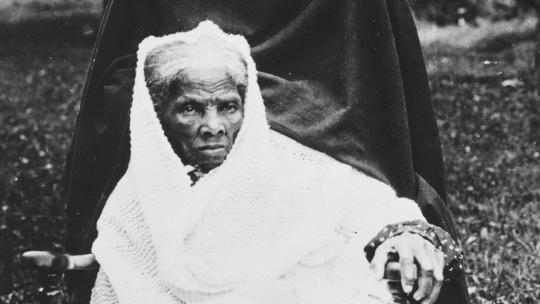
This December, we will be releasing our newest book, Harriet Tubman For Beginners by Annette Alston and illustrated by Lynsey Hutchinson. Alston delves into Tubman’s achievements, hardships, and faith while Hutchinson’s artwork punctuates the pages. Follow this blog to learn more about Harriet’s life and legacy.
Photo credits: 1 & 2
1 note
·
View note
